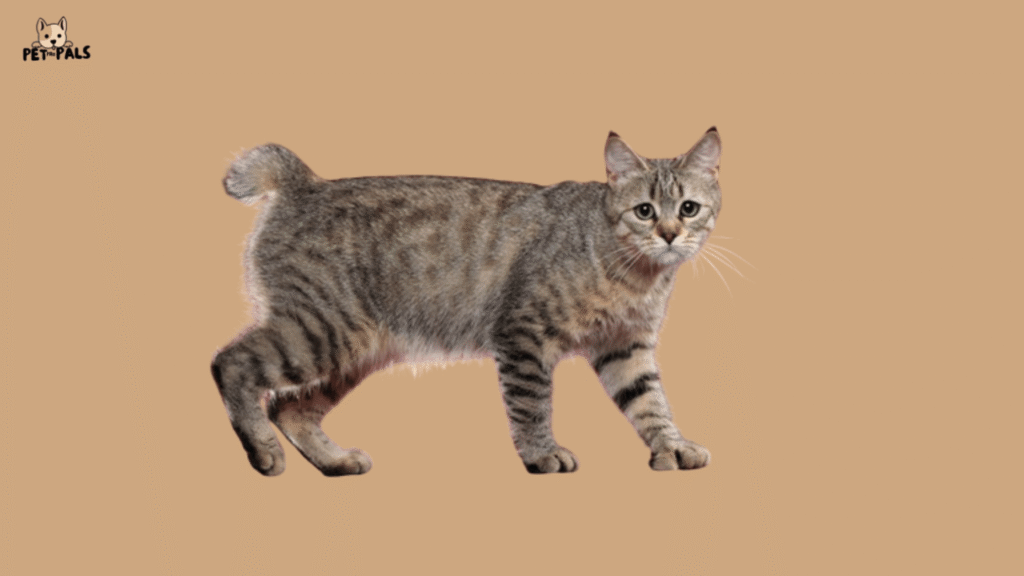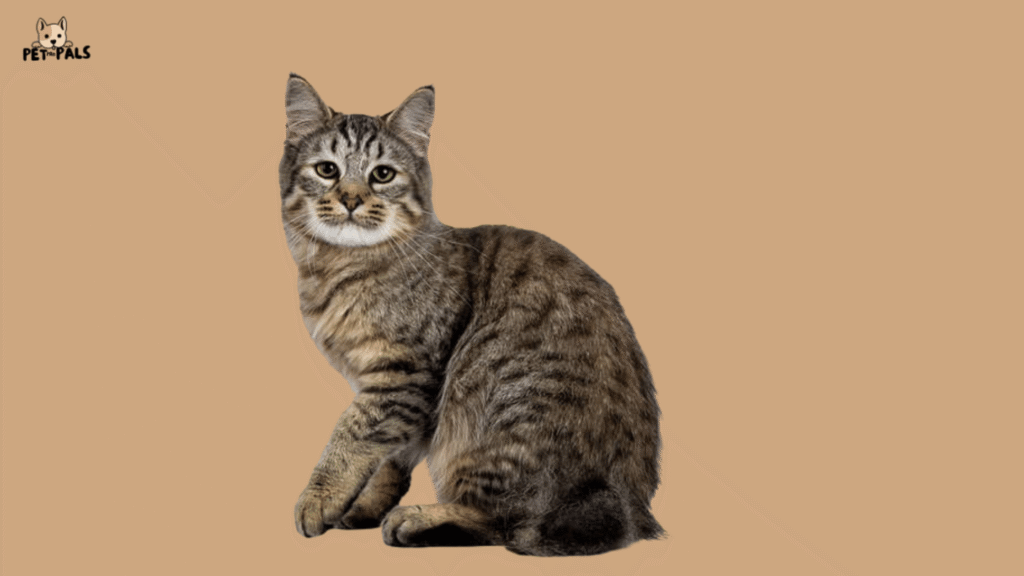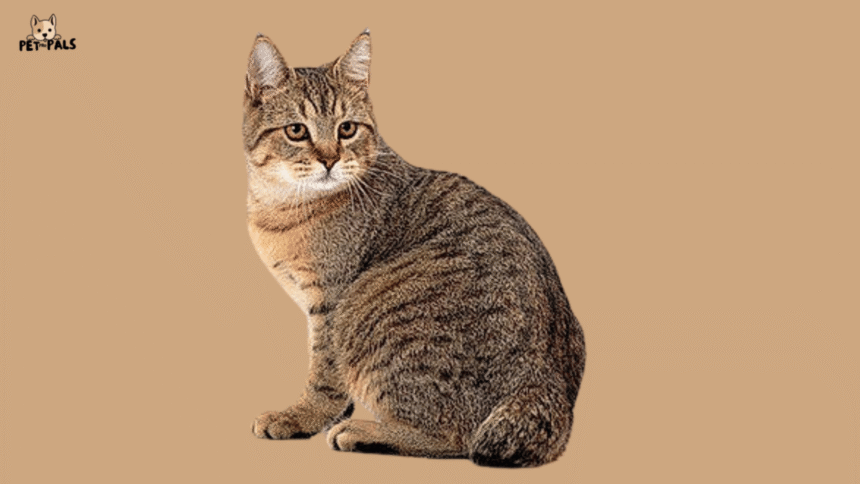If you’ve ever dreamed of having a mini wildcat lounging on your sofa, the Pixie Bob cat might be the feline of your dreams. With its rugged appearance, tufted ears, and bobbed tail, this breed could easily be mistaken for a tiny bobcat prowling through your living room. But don’t let their exotic look fool you; despite their striking resemblance to wildcats, Pixie Bobs are fully domestic and incredibly affectionate.
Recognized for their wild appearance and laid-back personality, Pixie Bob cats have built a loyal following among cat lovers who want something a little different. They’re a favorite among fans of exotic-looking cat breeds that still fit comfortably into a home environment.
It’s not just the look that draws attention, these cats have a personality that’s often described as “dog-like,” forming strong bonds with their humans, following them around the house, and even enjoying leash walks.
This guide will walk you through everything you need to know about the Largest Domestic Cat breed, from their origin story to personality traits, typical Pixie Bob cat size, pricing, and more. Whether you’re curious about how rare they are or considering bringing a Pixie Bob kitten into your family, you’ll find the insights you need here.
History and Origins of Pixie Bob Cat

The origin of the Pixie Bob cat is as intriguing as the breed itself. Often surrounded by mystery and wild speculation, these cats are said to be the result of natural matings between domestic cats and wild bobcats in the Pacific Northwest region of the United States. The idea of owning a domestic cat that looks like a bobcat certainly adds to the breed’s appeal, but what’s the real story?
It all began in the 1980s with a cat lover and breeder named Carol Ann Brewer, who lived in Washington state. In 1985, she rescued a large, bobtailed male cat with a wild look that many believed had some bobcat blood in him. Soon after, she acquired another unique male, this one also bobtailed and polydactyl (meaning he had extra toes, a trait that’s not uncommon in polydactyl cats). She bred these cats with domestic females, and one of their kittens, named Pixie, became the foundation of the breed. Thus, the Pixie Bob cat was born, named after the kitten who started it all.
Although early stories claimed these cats were part wild, genetic testing has shown no verified bobcat DNA in the Pixie Bob breed. Despite their rugged, untamed appearance, they are 100% domestic cats. This clarification is important because owning a true hybrid cat (like a Savannah or Bengal) often comes with legal and behavioral complications, while Pixie Bobs are much easier to integrate into a family setting.
The breed was officially recognized by the International Cat Association (TICA) in the mid-1990s, and since then, it has been celebrated for its exotic look combined with a gentle, dog-like temperament. While the myth of wild ancestry persists in pop culture, breeders and experts emphasize that Pixie Bobs are entirely domestic, making them a great choice for those who love the look of the wild, without the unpredictability.
Physical Appearance of Pixie Bob Cat
The Pixie Bob cat stands out instantly, thanks to its unmistakable wildcat vibe. But beyond just the bobbed tail and intense gaze, there’s a lot of variety and uniqueness in how this breed looks, making it one of the most exotic-looking cat breeds you can welcome into your home.
Size: Medium to Large
Pixie Bobs are considered a medium to large cat breed, with adult males typically weighing between 11 to 17 pounds, and females ranging from 8 to 12 pounds. They have a solid, muscular build and a bit of heft, giving them a more rugged feel than many traditional house cats. Despite their size, they’re agile and surprisingly graceful.
Coat: Types, Colors, and Texture
One of the most striking features of the Pixie Bob is its coat. They come in both short-haired and long-haired varieties, but regardless of length, the texture tends to be soft and woolly. Their coats are often described as weather-resistant, ideal for a breed that originated in the colder parts of the Pacific Northwest.
Coat colors are typically muted and natural-looking, mimicking the camouflage of wild bobcats. Most Pixie Bob kittens and adults display brown spotted tabby patterns, with rosettes, ticking, or even ghost striping. This helps them maintain that rugged, outdoor aesthetic even while lounging on your windowsill.
Tail: Naturally Bobbed
As their name suggests, Pixie Bobs are known for their bobbed tails, a trait that can vary quite a bit. Some have very short tails, just a couple of inches long, while others may have tails up to half the normal length of a standard cat’s. Tails may be kinked or straight, but they always contribute to the breed’s wildcat illusion.
Polydactylism: The Extra Toed Charm
A particularly unique trait among Pixie Bobs is polydactylism, a condition where cats are born with extra toes. While most cats have 18 toes (five on each front paw and four on each back paw), polydactyl Pixie Bobs can have up to seven toes on a single foot. Not only does this give them a quirky, endearing look, but it also adds to their sturdy, “built-for-the-wild” vibe.
Personality and Temperament of Pixie Bob Cat
Don’t let the fierce look fool you; the Pixie Bob cat personality is anything but wild. Behind those intense eyes and rugged features is a cat that’s social, playful, and surprisingly gentle. Many owners describe Pixie Bobs as having more in common with dogs than typical felines.
Social Behavior: Friendly, Playful, Bold
Pixie Bobs are known for being friendly cat breeds that thrive on interaction. They’re not the type to hide under the bed when guests arrive. Instead, they’ll likely stroll into the room, check out the scene, and maybe even climb into someone’s lap. Their boldness doesn’t translate into aggression—these cats are calm, confident, and deeply bonded with their humans.
They love being involved in family life. Whether you’re watching TV, cooking dinner, or working from home, don’t be surprised if your Pixie Bob follows you from room to room. They’re naturally curious and enjoy being part of the action without being overly demanding for attention.
Great with Kids and Other Pets
One of the reasons Pixie Bobs are gaining popularity as family pets is their tolerant and gentle nature around children and other animals. They’re patient with kids, don’t spook easily, and usually handle noisy or chaotic environments better than many other breeds.
When it comes to other pets, especially other cats or even dogs, Pixie Bobs tend to be chill and adaptable. Their easy-going personality helps them integrate well into multi-pet households, and their social instincts often lead to strong bonds with both humans and animals.
Intelligence and Trainability
If you’ve ever wanted a cat you can train, the Pixie Bob is it. They’re highly intelligent and often eager to please, which makes basic training surprisingly easy. Many owners teach their Pixie Bobs to walk on a leash, play fetch, or respond to simple commands like “sit” or “come.” Some even learn how to open doors or solve puzzle feeders.
Don’t let the fierce look fool you; the Pixie Bob cat personality is anything but wild. Behind those intense eyes and rugged features is a cat that’s social, playful, and surprisingly gentle. Many owners describe Pixie Bobs as having more in common with dogs than typical felines.
Pixie Bob Cat’s Health and Lifespan

Like most well-bred domestic cats, the Pixie Bob enjoys a relatively long and healthy life. With the right care, a balanced diet, and regular veterinary checkups, these rugged-looking felines can live anywhere from 13 to 15 years, sometimes even longer, in peaceful, indoor environments.
Lifespan: A Long-Term Companion
The average lifespan of a Pixie Bob cat falls comfortably within the typical range for domestic cats. Many owners report their cats living well into their mid-teens, especially when provided with a stress-free home, proper nutrition, and preventive healthcare.
That longevity makes them an ideal family pet for those looking for a long-term companion. Whether you’re raising a Pixie Bob kitten or adopting a young adult, you can expect many years of affectionate, engaging company.
Common Health Issues
Overall, Pixie Bobs are considered a healthy and hardy breed, thanks in part to their relatively recent and carefully managed development. However, as with all purebred cats, there are a few health considerations to keep in mind:
- Hypertrophic Cardiomyopathy (HCM): This heart condition is not widespread in Pixie Bobs but has been seen in some lines. Responsible breeders screen for it.
- Cryptorchidism: This is a condition where one or both testicles fail to descend in males. It’s not life-threatening, but it does require veterinary attention.
- Obesity: Because Pixie Bobs are stocky and often laid-back, they can be prone to weight gain if not kept active with regular play and enrichment.
One trait that’s often brought up is polydactylism, the presence of extra toes. It’s a unique and endearing feature of the breed and is generally harmless. In some rare cases, if the extra toes are poorly formed, they might need monitoring, but most polydactyl cats live perfectly healthy lives without any special treatment.
Responsible Breeding and Vet Care
Because the Pixie Bob cat is still considered relatively rare, it’s especially important to choose a breeder who prioritizes health and ethics. A responsible breeder will provide:
- Complete health records
- Genetic testing for known issues
- A clean, well-socialized environment for kittens
Avoid breeders offering Pixie Bob cats for sale at unusually low prices or without proper documentation—this often signals poor breeding practices, which can result in long-term health and behavioral problems.
Are Pixie Bob Cats Legal and Safe to Own?
Despite their wild appearance, Pixie Bob cats are fully domestic and legal to own in most regions. While early breeders believed they descended from bobcats, DNA testing has confirmed there are no wild genes in the breed.
Because they’re not hybrids, Pixie Bobs don’t face the legal restrictions that affect exotic or wild cat breeds. In the U.S. and many other countries, they’re treated like any other domestic cat no special permits needed.
As for safety, Pixie Bobs are known for being friendly, calm, and sociable, making them great for families, kids, and other pets. You get the appeal of an exotic-looking cat breed without the risks or legal red tape.
Pixie Bob Cat Price & Buying Tips
If you’re thinking of bringing home a Pixie Bob, it’s good to know what to expect in terms of cost and where to find one responsibly.
Average Cost
On average, a Pixie Bob kitten from a reputable breeder will cost between $800 and $1,500. Show-quality cats or those with rare traits (like pronounced polydactylism) can go for even more. Adult cats or retired breeders may be available at lower prices.
What Affects the Price?
Several factors influence the Pixie Bob cat price, including:
- Pedigree: Cats from champion bloodlines usually cost more.
- Breeder reputation: Ethical breeders who prioritize health and socialization may charge higher fees.
- Physical traits: Cats with strong bobcat-like features, short tails, or polydactyl paws often fetch premium prices.
- Location: Prices can vary by region and breeder availability.
Choosing a Reputable Breeder
To avoid scams or poorly bred kittens, look for breeders who:
- Are TICA-registered or affiliated with recognized cat organizations?
- Provide health records and genetic testing.
- Let you visit or video chat to meet the kittens and parents.
- Avoid selling to pet stores or offering kittens too young (under 12 weeks).
If someone is advertising Pixie Bob cats for sale at a steep discount with little background info, walk away. Cheap often comes with hidden costs.
Adoption vs. Buying
While Pixie Bobs are still considered rare, it’s possible to find one through rescue organizations or breed-specific groups. Adoption usually costs much less, around $100 to $300, and helps give a cat a second chance.
Whether you adopt or buy, make sure you’re prepared for the responsibility of owning this loyal and intelligent domestic cat that looks like a bobcat. Either way, you’re getting a one-of-a-kind companion.
Conclusion
The Pixie Bob cat is truly one of a kind. With its wild, bobcat-inspired appearance and calm, affectionate nature, it’s no surprise this breed has captured the hearts of cat lovers everywhere. Between their social personalities, unique features like bobbed tails and polydactyl paws, and their ability to bond deeply with their humans, Pixie Bobs offer the best of both worlds an exotic-looking cat breed with the heart of a gentle companion.
Owning a Pixie Bob is a rewarding experience, but like any pet, it comes with responsibility. These cats thrive in homes where they’re given attention, stimulation, and regular care. Whether you’re drawn to their look, their loyalty, or their playful charm, they’re more than just pretty faces; they’re intelligent, loving family members.
If you’re considering adding a Pixie Bob kitten to your household, take your time to do the research. Find a reputable breeder or consider adoption, understand their needs, and prepare for a long-term commitment. In return, you’ll gain a loyal friend who’s always up for an adventure or a cozy nap by your side.
Frequently Asked Questions
Are Pixie Bob cats rare?
Yes, Pixie Bob cats are considered a rare breed. Though they’re recognized by organizations like TICA, their numbers are still limited compared to more common domestic breeds. This rarity is one reason why the Pixie Bob cat price tends to be higher and why it’s important to seek out responsible breeders.
Can they have long tails?
Absolutely. While most Pixie Bobs have the classic bobbed tail, some are born with medium or even full-length tails. This variation is normal and accepted within the breed standard. Whether short or long, the tail always contributes to that signature bobtail cat breed look.
Are they good for first-time cat owners?
Yes, they can be a great choice for beginners. Pixie Bobs are friendly cat breeds that are affectionate, social, and easygoing. Their personality is often described as dog-like. They’re intelligent, loyal, and even enjoy leash walks and interactive play. Just be ready for their need for attention and mental stimulation.
How to tell if your cat is a true Pixie Bob?
A true Pixie Bob cat will have certain key traits: a wild, bobcat-like face, a spotted coat, a muscular build, and often polydactyl paws (extra toes). But appearance alone isn’t enough. To confirm, check if your cat came from a breeder registered with an organization like TICA and ask for pedigree documentation. Without papers, it can be difficult to confirm if a domestic cat that looks like a bobcat is a true Pixie Bob or just resembles one.

